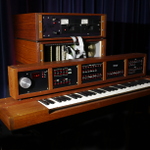

Synclavier bits and pieces
Welcome to the sounds of the incredibly rare Synclaiver Model 1. Built in 1978, this instrument was the very first commercially available digital synthesizer. Only 13 units were built, before the much more widely known successor, known as the Synclavier II, was introduced.
The first model could create sounds with additive and FM synthesis, allowing for a wide range of sounds. Because system software was required to load at startup from a floppy disk, programmers at several university research labs thought of new and ingenious ways to use the hardware which greatly expanded the creative possibilities.
The following excerpts from various compositions by Stefan Schramm give a good idea of the sound, but can certainly not come even close to describing as to what is possible on this instrument.
| Alias (excerpt) | Alias explores microtonal possibilities combined with playing notes on 'alias' frequencies which occur as a result of the Synclavier's lack of an anti-aliasing filter. Very low and very high frequencies result in what sounds almost like random noise. | |
| Arpeg (2nd movt.) | Arpeg is a composition that allows for a wide range of textures, from occasional sound events, to an onslaught of notes. The title refers to its basic programming structure which plays arpeggios. In this excerpt, these are easy to make out. | |
| Chances (excerpt) | Chances plays from a fixed set of pitches and durations. Voices are only allowed to pick the same or adjacent pitch or duration from a table. The pitch table contains a scale, the durations are 1/16, 1/8, 1/8 triplet, 1/4, 1/2, or 1/1 beats. In the original version, there is a dialog with a Buchla 200 system interfaced to the Synclavier. It plays some percussive sounds on every cadence in the Synclavier part. These sounds are omitted in this excerpt. | |
| Phase (excerpt) | Phase is a study which demonstrates that the kind of phase shifting in minimal music, made famous by composers like Steve Reich, which is basically impossible to recreate on the Synclavier with the supplied software, is actually very simple to do in Moxie (an extension to the Synclaviers XPL programming language developed by Doug Collinge at the University of Victoria). The user code for this study is only 24 lines long. | |
| Toccata | Toccata noodles randomly on a harmonic minor scale using an organ-type sound. Several parameters can be input at runtime, including horizontal (as in this version) or vertical (chord) playing, tempo, number of voices, and different sound presets. Slight pitch variations give a richer sound when two voices happen to pick the same pitch. | |
| Download | If you cannot play the audio above or prefer to download the tagged mp3 files, click here. | |
